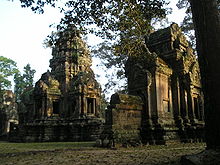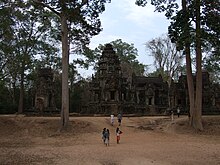Thommanon
The Thommanon and the Chau Say Tevoda are two small, originally Hindu, flat temples in the immediate vicinity of the historic city of Angkor Thom ( Cambodia ). The name "Thommanon" is younger than the temple; it is derived from the Pali words dhamma (law; teaching; reality) and anantapannya , or nanda for short (endless wisdom).
history
If you leave Angkor Thom through the “Siegestor”, the Thommanon and the Chau Say Tevoda are like twins to the left and right of the “Siegesallee” leading to the Ta Keo . However, Thommanon, Chau Say Tevoda and Siegesallee date from different times.
The Thommanon was built at the end of the 11th, at the latest in the middle of the 12th century; the stylistic relationship to Angkor Wat is unmistakable, so a dating to the reign of the Khmer king Suryavarman II (1113–1150) is likely. The Chau Say Tevoda was probably also built under Suryavarman II, but a little later than the Thommanon. Siegesallee was only built around 1200, at the same time as Angkor Thom.
Over the centuries the surrounding walls of the two temples have largely disappeared; Since Siegesallee runs from west to east and the main entrances to both temples are in the east, passers-by can now see the flanks of the complexes directly. While the Thommanon was completely restored in the 1960s, the Chau Say Tevoda is in a comparatively dilapidated state.
Plant and building decorations
Today, the Thommanon essentially consists of four sandstone buildings, which are lined up on an approximately 70 m long axis from east to west: the eastern gopura (gate tower), the mandapa (assembly hall), the prasat (temple tower), and finally the western gopura . Mandapa and Prasat are connected by a short antarala (corridor). A few meters south of the Mandapa is a fifth sandstone building, a so-called library or sacristy. The remains of the surrounding wall consist of laterite .
The eastern gopura has three passages and two side chambers; Reliefs in the side triangles of the gable represent Vishnu . The six meters long and three meters wide mandapa is covered with false tiles, tiles imitated in sandstone , and opens up in the four cardinal directions ; the best-preserved reliefs are on the inside above the eastern entrance (Vishnu on Garuda ) and inside above the western entrance (death of Valine), also on the outside above the southern entrance ( Ravana shakes Mount Kailash ).
The floor plan of the Prasat is cross-shaped - four vestibules surround the sanctuary, which measures approximately 3 × 3 m inside and is crowned by a tower roof in the Angkor Wat style. Access to the central room is only possible from the eastern vestibule; in the other vestibules one comes across extremely finely decorated false stone doors. The outer walls of the building are also richly decorated: the beautiful Devata with their feet pointing to the side correspond to those of Angkor Wat.
The western gopura keeps a clear distance to the Prasat and is kept simpler than the eastern gopura. But here, too, the reliefs are remarkable: In the side triangles of the gable you can see Shiva as an ascetic (south side) and the whirling of the sea of milk (north side); Outside, above the middle passage, Vishnu riding on Garuda is fighting an Asura .
Sources and further information
literature
- Michael Freeman and Claude Jacques: Ancient Angkor . River Books, Bangkok 1999, ISBN 974-8225-27-5 .
- Luca Invernizzi Tettoni and Thierry Zéphir: Angkor. A tour of the monuments . Archipelago Press, Singapore 2004, ISBN 981-4068-73-X .
- Nick Ray: Cambodia . Lonely Planet Publications, Victoria 2005, ISBN 1-74059-525-4 .
- Johann Reinhart Zieger: Angkor and the Khmer temples in Cambodia . Silkworm Books, Chiang Mai 2006, ISBN 974-9575-60-1 .
Individual evidence
- ↑ Zieger p. 72, p. 239 and p. 242.
- ↑ Dating from Zieger, p. 72.
- ^ Freeman and Jacques p. 124.
- ^ Freeman and Jacques p. 128.
- ^ Freeman and Jacques p. 74.
- ^ Freeman and Jacques p. 124.
- ^ Freeman and Jacques p. 128.
- ↑ Zieger p. 73.
- ↑ Dimensions according to Zieger p. 72.
Web links
Coordinates: 13 ° 26 ′ 49.6 ″ N , 103 ° 52 ′ 38.5 ″ E


